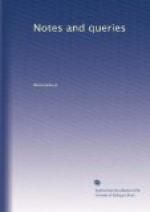2. I am said to have “repeated what C. had already stated.”—I consulted the Shakspere of Malone, and verified my recollections, when the query of “Mr. JEBB” appeared—but forbore to notice its misconceptions. Besides, one C., after an interval of two months, merely asserted that it was not a blunder of Malone; the other C. furnished, off-hand, his proofs and references.
3. To argue fairly, we must use the same words in the same sense. Now C. (No. 24. p. 386.) asserts the Malone had never seen the introductory fragment; and asks, who forged it? He uses the word fabrication in the sense of forgery.—The facts are produced (No. 25. p. 404.). He is informed that the audacious fabrication, which took place before 1770, was first published by Malone himself, in 1790—yet he expects me to apply the same terms to the blunder committed by another editor in 1794.
4. As an answer to my assertion that the Irish editor attempted to unite the two fragments, C. proceeds to prove that he did not unite them. The procedure is rather defective in point of logical exactness. It proves only what was not denied. Malone refers to the will of John Shakspere, found by Joseph Moseley, with sufficient clearness; and it is charitable to assume that the Irish editor intended to observe the instructions of his precursor. He failed, it seems—but why? It would be useless to go in search of the rationale of a blunder.
Have I “mistaken the whole affair"?—I entreat those readers of the “NOTES AND QUERIES” who may take up the affirmative side of the question to point out my errors, whether as to facts or inferences.
BOLTON CORNET.
* * * * *
AUTHORS WHO HAVE PRIVATELY PRINTED THEIR OWN WORKS.
Can any of your readers refer me to any source whence I can obtain an account of “JOHN PAINTER, B.A. of St. John’s College, Oxford?” He appears to have been a very singular character, and fond of printing (privately) his own lucubrations; to most of which he subscribes himself “The King’s Fool.” Three of these privately printed tracts are now before me:—1. The Poor Man’s Honest Praises and Thanksgiving, 1746. 2. An Oxford Dream, in Two Parts, 1751. 3. A Scheme designed for the Benefit of the Foundling Hospital, 1751.
Who was ROBERT DEVERELL, who privately printed, in 4to., Andalusia; or Notes tending to show that the Yellow Fever was well known to the Ancients? The book seems a mass of absurdity; containing illustrations of Milton’s Comus, and several other subjects equally incongruous.
EDWARD F. RIMBAULT.
* * * * *
MINOR QUERIES.




